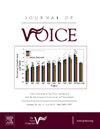用模糊三角 Naive Bayes(一种机器学习分类器)识别声乐练习的效果:初步分析。
IF 2.5
4区 医学
Q1 AUDIOLOGY & SPEECH-LANGUAGE PATHOLOGY
引用次数: 0
摘要
目标:机器学习(ML)方法允许开发专家系统,用于模式识别和干预结果的预测分析。它已被用于嗓音科学,主要用于区分健康嗓音和发音障碍嗓音。在使用改善健康嗓音或发音障碍嗓音的技术后,ML 分类器(如模糊三角 Naive Bayes (FTriangNB))可对嗓音声学分析和嗓音感知评估的参数模式进行评估。因此,本研究的目的是分析 FTriangNB 的性能,以检测 12 名发音障碍女性和 12 名声乐健康女性在进行三种发声练习(颤舌、高阻力吸管半闭合声道练习--SOVTE 和过度发音)后的声学参数和听觉感知评估的模式:在 Macintosh 版 R Studio 1.4.1106 数据分析软件中实现了 Fuzzy Class 软件包中的 FTriangNB 分类器。提取了混淆矩阵、准确率、卡帕系数和类统计量。将最终结果与 FTriangNB 用练习应用前数据库中的相同变量生成的结果进行了比较:结果:FTriangNB 的准确率(87.5%)和 Kappa 系数(81.3%)都很高,并且在使用练习后显示出几乎完美的一致性,而使用练习前的结果则显示出准确率不高(33.3%)和 Kappa 系数一致性较差(-6.67%)。高强度吸管半闭塞声道练习(SOVTE)的灵敏度和负预测值(NPV)均为 1(1),过度发音的特异性和正预测值(PPV)也为 1(1):结论:FTriangNB 在识别发声练习效果方面表现出极高的准确性。为此,嗓音科学界应进一步利用 FTriangNB 及其他机器学习分类器对更多样本进行探索性研究,以便做出推论。本文章由计算机程序翻译,如有差异,请以英文原文为准。
Recognition of the Effect of Vocal Exercises by Fuzzy Triangular Naive Bayes, a Machine Learning Classifier: A Preliminary Analysis
Objectives
Machine learning (ML) methods allow the development of expert systems for pattern recognition and predictive analysis of intervention outcomes. It has been used in Voice Sciences, mainly to discriminate between healthy and dysphonic voices. Parameter patterns of vocal acoustic analysis and vocal perceptual assessment can be evaluated by ML classifiers, such as the Fuzzy Triangular Naive Bayes (FTriangNB), after using techniques that improve the vocal quality of individuals with healthy or dysphonic voices. Thus, the goal of this study was to analyze the performance of the FTriangNB to detect patterns in the acoustic parameters and the auditory-perceptual assessment of 12 women with dysphonia and 12 vocally healthy women, after performing three vocal exercises (tongue trills, semi-occluded vocal tract exercise with a high-resistance straw – SOVTE, and over-articulation).
Methods
The FTriangNB classifier contained in the Fuzzy Class package was implemented in the data analysis software R Studio version 1.4.1106 for Macintosh. The confusion matrix was extracted, as well as the accuracy, the Kappa coefficient, and the class statistics. The final result was compared with those generated by FTriangNB with the same variables from the preapplication database of the exercises.
Results
The FTriangNB presented good accuracy (87.5%) and Kappa coefficient (81.3%), and showed almost perfect agreement after application of the exercises, while the results before the application of the exercises demonstrated accuracy without acceptable discrimination capacity (33.3%) and Kappa coefficient with a poor agreement (-6.67%). The Semioccluded Vocal Tract Exercises (SOVTE) with high strength straw presented with a sensitivity and Negative Predictive Value (NPV) of value 1 (one), and the over-articulation's specificity and Positive Predictive Value (PPV) also showed a value of 1 (one).
Conclusions
The FTriangNB showed great accuracy in recognizing the effect of vocal exercises. Exploratory studies with larger samples using FTriangNB, as well as other Machine Learning classifiers should be further carried out for this purpose in the Voice Science to enable inferences.
求助全文
通过发布文献求助,成功后即可免费获取论文全文。
去求助
来源期刊

Journal of Voice
医学-耳鼻喉科学
CiteScore
4.00
自引率
13.60%
发文量
395
审稿时长
59 days
期刊介绍:
The Journal of Voice is widely regarded as the world''s premiere journal for voice medicine and research. This peer-reviewed publication is listed in Index Medicus and is indexed by the Institute for Scientific Information. The journal contains articles written by experts throughout the world on all topics in voice sciences, voice medicine and surgery, and speech-language pathologists'' management of voice-related problems. The journal includes clinical articles, clinical research, and laboratory research. Members of the Foundation receive the journal as a benefit of membership.
 求助内容:
求助内容: 应助结果提醒方式:
应助结果提醒方式:


